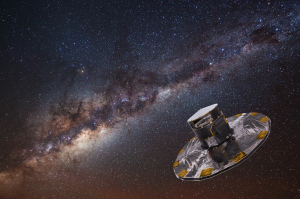Europe bids Gaia a safe journey
27 June 2013
ESA's billion-star surveyor, Gaia, has completed final preparations in Europe and is ready to depart for its launch site in French Guiana, set to embark on a five-year mission to map the stars with unprecedented precision.| Gaia scanning the sky. Credit: ESA - C. Carreau (Click here for further details and larger versions of this video.) |
Gaia's main goal is to create a highly accurate 3D map of our Milky Way Galaxy by repeatedly observing a billion stars to determine their precise positions in space and their motions through it.
Other measurements will assess the vital physical properties of each star, including its temperature, luminosity and composition.
The resulting census will allow astronomers to determine the origin and the evolution of our Galaxy.
Gaia will also uncover tens of thousands of previously unseen objects, including asteroids in our Solar System, planets around nearby stars, and exploding stars – supernovas – in other galaxies.
"Gaia will be ESA's discovery machine," says Alvaro Giménez, ESA's Director of Science and Robotic Exploration.
"It will tell us what our home Galaxy is made of and how it was put together in greater detail than ever before, putting Europe at the forefront of precision astronomy.
"Gaia builds on the technical and scientific heritage of ESA's star-mapping Hipparcos mission, reflecting the continued expertise of the space industry and the scientific community across Europe.
"It's extremely rewarding to see the next generation of our high-precision observatories built and ready to answer fundamental questions about the cosmos."
Gaia will be launched later in 2013 on an Arianespace Soyuz rocket from Europe's Spaceport in Kourou, French Guiana, and will map the stars from an orbit around the Sun, near a location some 1.5 million km beyond Earth's orbit known as the L2 Lagrangian point.
 |
|
Gaia mapping the stars of the Milky Way. Credit: ESA/ATG medialab; background image: ESO/S. Brunier |
During its five-year mission, the spacecraft will spin slowly, sweeping its two telescopes equipped with the largest digital camera ever flown in space – with nearly a billion pixels – across the entire sky.
Gaia will measure a billion stars, roughly 1% of all the stars spread across the Milky Way.
As Gaia moves around the Sun, it will repeatedly measure the position of each star, allowing it to determine the distance through a perspective effect known as parallax.
Combined with the other measurements, these data will equip astronomers with the information they need to reconstruct the history of the Milky Way.
The mission will also discover new asteroids in our own Solar System and planets orbiting around other stars.
Gaia should even be able probe the distribution of dark matter, the invisible substance that is detected only through its gravitational influence on celestial objects.
It will test Einstein's General Theory of Relativity by watching how light is deflected by massive objects like the Sun and its planets, as well as other stars.
"Gaia will observe each of its billion stars 70 times on average over five years. That works out as some 40 million observations per day!" says Giuseppe Sarri, ESA's Gaia Project Manager.
"The herculean effort of processing all of the data will be carried out by the European scientific community working with ESA," adds Timo Prusti, ESA's Gaia Project Scientist.
"The resulting huge stellar census will provide the information needed to tackle an enormous range of important problems related to the origin, structure and evolutionary history of our home Galaxy."
For further information, please contact:
Markus Bauer
ESA Science and Robotic Exploration Communication Officer
Tel: +31 71 565 6799
Mob: +31 61 594 3 954
Email: Markus.Bauer![]() esa.int
esa.int
Giuseppe Sarri
Gaia Project Manager
Email: Giuseppe.Sarri![]() esa.int
esa.int
Timo Prusti
Gaia Project Scientist
Email: Timo.Prusti![]() esa.int
esa.int
(This article was originally posted on ESA's Space Science Portal.)


